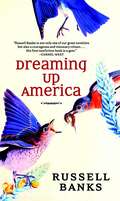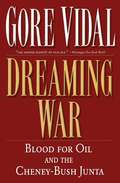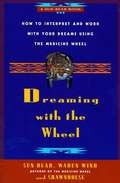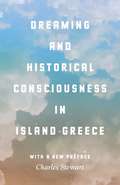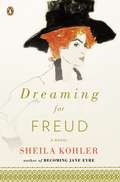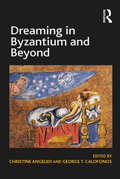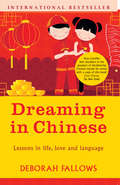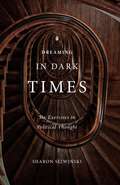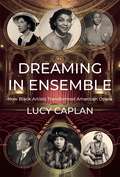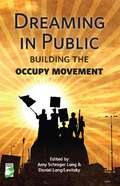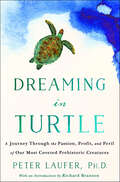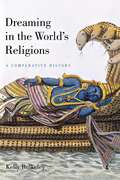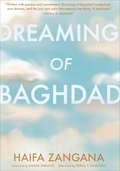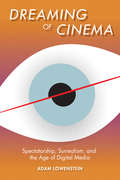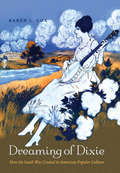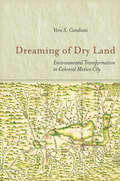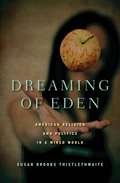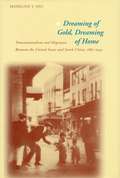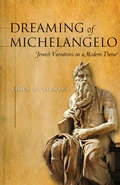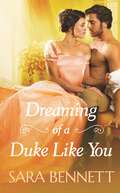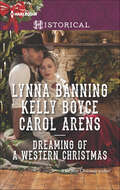- Table View
- List View
Dreaming Up America
by Russell BanksWith America ever under global scrutiny, Russell Banks contemplates the questions of our origins, values, heroes, conflicts, and contradictions. He writes with conversational ease and emotional insight, drawing on contemporary politics, literature, film, and his knowledge of American history.
Dreaming War: Blood for Oil and the Cheney-Bush Junta (Nation Books)
by Gore VidalWhen Gore Vidal's recent New York Times bestseller Perpetual War for Perpetual Peace was published, the Los Angeles Times described Vidal as the last defender of the American republic. In Dreaming War, Vidal continues this defense by confronting the Cheney-Bush junta head on in a series of devastating essays that demolish the lies American Empire lives by, unveiling a counter-history that traces the origins of America's current imperial ambitions to the experience of World War Two and the post-war Truman doctrine. And now, with the Cheney-Bush leading us into permanent war, Vidal asks whose interests are served by this doctrine of pre-emptive war? Was Afghanistan turned to rubble to avenge the 3,000 slaughtered on September 11? Or was "the unlovely Osama chosen on aesthetic grounds to be the frightening logo for our long contemplated invasion and conquest of Afghanistan?" After all he was abruptly replaced with Saddam Hussein once the Taliban were overthrown. And while "evidence" is now being invented to connect Saddam with 9/11, the current administration are not helped by "stories in the U. S. press about the vast oil wealth of Iraq which must- for the sake of the free world- be reassigned to U. S. consortiums. "
Dreaming With the Wheel: How to Interpret Your Dreams Using the Medicine Wheel
by Sun Bear Wabun Wind ShawnodeseAn explanation of the dream-interpretation principles of the Native American medicine wheel.The authors of The Medicine Wheel explore different views of dreamtime, both historic and contemporary, to provide an explanation of the dream-interpretation principles of the Native American medicine wheel—and a new framework for working with dreams.
Dreaming and Historical Consciousness in Island Greece (Cultural Politics, Socioaesthetics, Beginnings Ser. #4)
by Charles StewartOn publication in 2012, Dreaming and Historical Consciousness in Island Greece quickly met wide acclaim as a gripping work that, according to the Times Literary Supplement, “offers a wholly new way of thinking about dreams in their social contexts.” It tells an extraordinary story of spiritual fervor, prophecy, and the ghosts of the distant past coming alive in the present. This new affordable paperback brings it to the wider audience that it deserves. Charles Stewart tells the story of the inhabitants of Kóronos, on the Greek island of Naxos, who, in the 1830s, began experiencing dreams in which the Virgin Mary instructed them to search for buried Christian icons nearby and build a church to house the ones they found. Miraculously, they dug and found several icons and human remains, and at night the ancient owners of them would speak to them in dreams. The inhabitants built the church and in the years since have experienced further waves of dreams and startling prophesies that shaped their understanding of the past and future and often put them at odds with state authorities. Today, Kóronos is the site of one of the largest annual pilgrimages in the Mediterranean. Telling this fascinating story, Stewart draws on his long-term fieldwork and original historical sources to explore dreaming as a mediator of historical change, while widening the understanding of historical consciousness and history itself.
Dreaming for Freud
by Sheila KohlerAn award-winning author reimagines one of Freud's most famous and controversial cases Acclaimed for her spare prose and exceptional psychological insights in her novels Becoming Jane Eyre and Love Child, Sheila Kohler's latest is inspired by Sigmund Freud's Dora: An Analysis of a Case of Hysteria. Dreaming for Freud paints a provocative and sensual portrait of one of history's most famous patients. In the fall of 1900, Dora's father forces her to begin treatment with the doctor. Visiting him daily, the seventeen-year-old girl lies on his ottoman and tells him frankly about her strange life, and above all about her father's desires as far as she is concerned. But Dora abruptly ends her treatment after only eleven weeks, just as Freud was convinced he was on the cusp of a major discovery. In Dreaming for Freud, Kohler explores what might have happened between the man who changed the face of psychotherapy and the beautiful young woman who gave him her dreams.
Dreaming in Byzantium and Beyond
by George T. CalofonosAlthough the actual dreaming experience of the Byzantines lies beyond our reach, the remarkable number of dream narratives in the surviving sources of the period attests to the cardinal function of dreams as vehicles of meaning, and thus affords modern scholars access to the wider cultural fabric of symbolic representations of the Byzantine world. Whether recounting real or invented dreams, the narratives serve various purposes, such as political and religious agendas, personal aspirations or simply an author’s display of literary skill. It is only in recent years that Byzantine dreaming has attracted scholarly attention, and important publications have suggested the way in which Byzantines reshaped ancient interpretative models and applied new perceptions to the functions of dreams. This book - the first collection of studies on Byzantine dreams to be published - aims to demonstrate further the importance of closely examining dreams in Byzantium in their wider historical and cultural, as well as narrative, context. Linked by this common thread, the essays offer insights into the function of dreams in hagiography, historiography, rhetoric, epistolography, and romance. They explore gender and erotic aspects of dreams; they examine cross-cultural facets of dreaming, provide new readings, and contextualize specific cases; they also look at the Greco-Roman background and Islamic influences of Byzantine dreams and their Christianization. The volume provides a broad variety of perspectives, including those of psychoanalysis and anthropology.
Dreaming in Chinese: ... and Discovering What Makes a Billion People Tick
by Deborah FallowsThis is a book to appeal to anyone with an interest in China, be they first time tourists, seasoned business people, or even the idly curious. Accessible, revelatory and entertaining, it will help you discover this extraordinary nation for yourself.
Dreaming in Dark Times: Six Exercises in Political Thought
by Sharon SliwinskiWhat do dreams manage to say—or indeed, show—about human experience that is not legible otherwise? Can the disclosure of our dream-life be understood as a form of political avowal? To what does a dream attest? And to whom? Blending psychoanalytic theory with the work of such political thinkers as Hannah Arendt and Michel Foucault, Sharon Sliwinski explores how the disclosure of dream-life represents a special kind of communicative gesture—a form of unconscious thinking that can serve as a potent brand of political intervention and a means for resisting sovereign power. Each chapter centers on a specific dream plucked from the historical record, slowly unwinding the significance of this extraordinary disclosure. From Wilfred Owen and Lee Miller to Frantz Fanon and Nelson Mandela, Sliwinski shows how each of these figures grappled with dream-life as a means to conjure up the courage to speak about dark times. Here dreaming is defined as an integral political exercise—a vehicle for otherwise unthinkable thoughts and a wellspring for the freedom of expression.Dreaming in Dark Times defends the idea that dream-life matters—that attending to this thought-landscape is vital to the life of the individual but also vital to our shared social and political worlds.
Dreaming in Ensemble: How Black Artists Transformed American Opera
by Lucy CaplanA revelatory new account of Black innovation in American opera, showing how composers, performers, and critics redefined the genre both aesthetically and politically in the early twentieth century.The inauguration of a “golden age” in Black opera is often dated to 1955, when Marian Anderson became the first Black singer to perform in a leading role at New York’s Metropolitan Opera. Yet Anderson’s debut was actually preceded by a rich Black operatic tradition that developed in the first half of the twentieth century. Lucy Caplan tells the stories of the Black composers, performers, critics, teachers, and students who created this vibrant opera culture, even as they were excluded from the genre’s most prominent institutions. Their movement, which flourished alongside the Harlem Renaissance, redefined opera as a wellspring of aesthetic innovation, sociality, and antiracist activism.Caplan argues that Black opera in the early twentieth century had decidedly countercultural ambitions. In opera’s sonic grandeur and dramatic maximalism, artists found creative resources for expressing the complexity of Black life. The protagonists of this story include composers Harry Lawrence Freeman and Shirley Graham, whose operas boldly interpreted Black diasporic history; performers Caterina Jarboro and Florence Cole-Talbert, who both starred in the racially fraught role of Aida; and critics Sylvester Russell and Nora Holt, who wrote imaginatively about the genre in the Black press. Yet Caplan also focuses on the many Black students, amateurs, opera house staff, and listeners who contributed indelibly to opera’s meanings.With the creation of new companies, choruses, and audiences, opera not only circulated in the Black public sphere but itself became a public sphere with radical potential.
Dreaming in French: The Paris Years of Jacqueline Bouvier Kennedy, Susan Sontag, and Angela Davis
by Kaplan Alice YaegerA year in Paris . . . since World War II, countless American students have been lured by that vision--and been transformed by their sojourn in the City of Light. Dreaming in French tells three stories of that experience, and how it changed the lives of three extraordinary American women. All three women would go on to become icons, key figures in American cultural, intellectual, and political life, but when they embarked for France, they were young, little-known, uncertain about their future, and drawn to the culture, sophistication, and drama that only Paris could offer. Yet their backgrounds and their dreams couldn't have been more different. Jacqueline Bouvier was a twenty-year-old debutante, a Catholic girl from a wealthy East Coast family. Susan Sontag was twenty-four, a precocious Jewish intellectual from a North Hollywood family of modest means, and Paris was a refuge from motherhood, a failing marriage, and graduate work in philosophy at Oxford. Angela Davis, a French major at Brandeis from a prominent African American family in Birmingham, Alabama, found herself the only black student in her year abroad program--in a summer when all the news from Birmingham was of unprecedented racial violence. Kaplan takes readers into the lives, hopes, and ambitions of these young women, tracing their paths to Paris and tracking the discoveries, intellectual adventures, friendships, and loves that they found there. For all three women, France was far from a passing fancy; rather, Kaplan shows, the year abroad continued to influence them, a significant part of their intellectual and cultural makeup, for the rest of their lives. Jackie Kennedy carried her love of France to the White House and to her later career as a book editor, bringing her cultural and linguistic fluency to everything from art and diplomacy to fashion and historic restoration--to the extent that many, including Jackie herself, worried that she might seem "too French. " Sontag found in France a model for the life of the mind that she was determined to lead; the intellectual world she observed from afar during that first year in Paris inspired her most important work and remained a key influence--to be grappled with, explored, and transcended--the rest of her life. Davis, meanwhile, found that her Parisian vantage strengthened her sense of political exile from racism at home and brought a sense of solidarity with Algerian independence. For her, Paris was a city of political commitment, activism, and militancy, qualities that would deeply inform her own revolutionary agenda and soon make her a hero to the French writers she had once studied. Kaplan, whose own junior year abroad played a prominent role in her classic memoir, French Lessons, spins these three quite different stories into one evocative biography, brimming with the ferment and yearnings of youth and shot through with the knowledge of how a single year--and a magical city--can change a whole life. No one who has ever dreamed of Paris should miss it.
Dreaming in Public
by Daniel Lang Levitsky Amy LangSince September 2011, the Occupy movement has captured the world's imagination. The media has been flooded with accounts of demonstrations, descriptions of the encampments, interviews with Occupiers, and discussions of Occupy's merits, political and otherwise. But what do its participants have to say? Dreaming in Public gathers together dispatches, essays, blog posts, and images from within the movement aimed at influencing its development and addressing those not yet in the streets and plazas. Produced by participant journalists, political analysts, writers, polemicists, photographers, organizers, and activists, these documents capture the vibrant, contentious, illuminating, and inventive exchange of Occupy. Work from contributors such as Naomi Klein and Harsha Walia complement public declarations from the movement, images, and graphics. Some pieces explore the rites and rituals of the movement, others its aims and overall structure. Yet others take up the role differences of race and gender play in a movement that claims to represent the 99%, and the complicated business of maintaining urban encampments. Many consider the challenge participatory democracy poses to conventional ideas of what politics is or should be. The materials in this collection attest not only to the extraordinary political energy that has already come out of Occupy, but to the implications of the movement for the future. Amy Schrager Lang is professor of English and humanities at Syracuse University and author of a number of books. Daniel Lang/Levitsky is an artist, theater producer, writer, and founding member of the Direct Action Network and Jews Against the Occupation.
Dreaming in Turtle: A Journey Through the Passion, Profit, and Peril of Our Most Coveted Prehistoric Creatures
by Peter LauferA fascinating exploration into the world of turtles across the globe; Laufer charts the lore, love, and peril to a beloved species.Dreaming in Turtle is a compelling story of a stalwart animal prized from prehistory through to today—an animal threatened by human greed, pragmatism, and rationalization. It stars turtles and shady and heroic human characters both, in settings ranging from luxury redoubts to degraded habitats, during a time when the confluence of easy global trade, limited supply, and inexhaustible demand has accelerated the stress on species. The growth of the middle class in high-population regions like China, where the turtle is particularly valued, feeds this perfect storm into which the turtle finds itself lashed. This is a tale not just of endangered turtles but also one of overall human failings, frailties, and vulnerabilities—all punctuated by optimistic hope for change fueled by dedicated turtle champions.
Dreaming in the World's Religions: A Comparative History
by Kelly BulkeleyFrom Biblical stories of Joseph interpreting Pharoh&’s dreams in Egypt to prayers against bad dreams in the Hindu Rg Veda, cultures all over the world have seen their dreams first and foremost as religiously meaningful experiences. In this widely shared view, dreams are a powerful medium of transpersonal guidance offering the opportunity to communicate with sacred beings, gain valuable wisdom and power, heal suffering, and explore new realms of existence. Conversely, the world&’s religious and spiritual traditions provide the best source of historical information about the broad patterns of human dream lifeDreaming in the World&’s Religions provides an authoritative and engaging one-volume resource for the study of dreaming and religion. It tells the story of how dreaming has shaped the religious history of humankind, from the Upanishads of Hinduism to the Qur&’an of Islam, from the conception dream of Buddhas mother to the sexually tempting nightmares of St. Augustine, from the Ojibwa vision quest to Australian Aboriginal journeys in the Dreamtime. Bringing his background in psychology to bear, Kelly Bulkeley incorporates an accessible consideration of cognitive neuroscience and evolutionary psychology into this fascinating overview.Dreaming in the World&’s Religions offers a carefully researched, accessibly written portrait of dreaming as a powerful, unpredictable, often iconoclastic force in human religious life.
Dreaming of Baghdad (Women Writing The Middle East Ser.)
by Haifa Zangana&“With passion and commitment,&” an exiled Iraqi woman recounts her time organizing resistance to Saddam Hussein and imprisonment in Abu Ghraib (Nawal El Saadawi, author of Zeina). In 1970s Iraq, the Ba&’ath Party was at the height of its influence in the Middle East and popularity throughout the West. But a group of activists recognized the disastrous potential of the regime as its charismatic leader, Saddam Hussein, came to power. Haifa Zangana was among those who resisted Saddam&’s rule, a small group of whom were captured and imprisoned at Abu Ghraib. Now, from a distance of time and place, Zangana writes about her incarceration, the agonizing loss of comrades to torture and death in prison, her safe yet haunted life so far away from friends, family, and her beloved country, and the ways memory conspires to make us forget. In this poetic, emotionally-tinged memoir, the author of Women on a Journey: Between Baghdad and London &“drags politics down from the realm of the abstract into the mud, fear, and loneliness of personal experience and psychological ruin that is life under dictatorship&” (Christian Parenti, author of The Freedom: Shadows and Hallucinations in Occupied Iraq).
Dreaming of Cinema
by Adam LowensteinAdam Lowenstein argues that Surrealism's encounter with film can help redefine the meaning of cinematic spectatorship in an era of popular digital entertainment.
Dreaming of Cinema: Spectatorship, Surrealism, and the Age of Digital Media (Film and Culture Series)
by Adam LowensteinVideo games, YouTube channels, Blu-ray discs, and other forms of "new" media have made theatrical cinema seem "old." A sense of "cinema lost" has accompanied the ascent of digital media, and many worry film's capacity to record the real is fundamentally changing. Yet the Surrealist movement never treated cinema as a realist medium and understood our perceptions of the real itself to be a mirage. Returning to their interpretation of film's aesthetics and function, this book reads the writing, films, and art of Luis Buñuel, Salvador Dalí, Man Ray, André Breton, André Bazin, Roland Barthes, Georges Bataille, Roger Caillois, and Joseph Cornell and recognizes their significance for the films of David Cronenberg, Nakata Hideo, and Atom Egoyan; the American remake of the Japanese Ring (1998); and a YouTube channel devoted to Rock Hudson. Offering a positive alternative to cinema's perceived crisis of realism, this innovative study enriches the meaning of cinematic spectatorship in the twenty-first century.
Dreaming of Cockaigne: Medieval Fantasies of the Perfect Life
by Herman Pleij Diane WebbImagine a dreamland where roasted pigs wander about with knives in their backs to make carving easy, where grilled geese fly directly into one's mouth, where cooked fish jump out of the water and land at one's feet. The weather is always mild, the wine flows freely, sex is readily available, and all people enjoy eternal youth. Such is Cockaigne. Portrayed in legend, oral history, and art, this imaginary land became the most pervasive collective dream of medieval times-an earthly paradise that served to counter the suffering and frustration of daily existence and to allay anxieties about an increasingly elusive heavenly paradise. Illustrated with extraordinary artwork from the Middle Ages, Herman Pleij's Dreaming of Cockaigne is a spirited account of a lost paradise and the world that brought it to life. Pleij takes three important texts as his starting points for an inspired of the panorama of ideas, dreams, popular religion, and literary and artistic creation present in the late Middle Ages. What emerges is a well-defined picture of the era, furnished with a wealth of detail from all of Europe, as well as Asia and America. Pleij draws upon his thorough knowledge of medieval European literature, art, history, and folklore to describe the fantasies that fed the tales of Cockaigne and their connections to the central obsessions of medieval life.
Dreaming of Cockaigne: Medieval Fantasies of the Perfect Life
by Herman PleijImagine a dreamland where roasted pigs wander about with knives in their backs to make carving easy, where grilled geese fly directly into one's mouth, where cooked fish jump out of the water and land at one's feet. The weather is always mild, the wine flows freely, sex is readily available, and all people enjoy eternal youth.Such is Cockaigne. Portrayed in legend, oral history, and art, this imaginary land became the most pervasive collective dream of medieval times-an earthly paradise that served to counter the suffering and frustration of daily existence and to allay anxieties about an increasingly elusive heavenly paradise.Illustrated with extraordinary artwork from the Middle Ages, Herman Pleij's Dreaming of Cockaigne is a spirited account of this lost paradise and the world that brought it to life. Pleij takes three important texts as his starting points for an inspired of the panorama of ideas, dreams, popular religion, and literary and artistic creation present in the late Middle Ages. What emerges is a well-defined picture of the era, furnished with a wealth of detail from all of Europe, as well as Asia and America.Pleij draws upon his thorough knowledge of medieval European literature, art, history, and folklore to describe the fantasies that fed the tales of Cockaigne and their connections to the central obsessions of medieval life.
Dreaming of Dixie
by Karen L. CoxFrom the late nineteenth century through World War II, popular culture portrayed the American South as a region ensconced in its antebellum past, draped in moonlight and magnolias, and represented by such southern icons as the mammy, the belle, the chivalrous planter, white-columned mansions, and even bolls of cotton. InDreaming of Dixie, Karen Cox shows that the chief purveyors of this constructed nostalgia for the Old South were outsiders of the region, especially advertising agencies, musicians, publishers, radio personalities, writers, and filmmakers playing to consumers' anxiety about modernity by marketing the South as a region still dedicated to America's pastoral traditions. Cox examines how southerners themselves embraced the imaginary romance of the region's past, particularly in the tourist trade as southern states and cities sought to capitalize on popular perceptions by showcasing their Old South heritage. Only when television emerged as the most influential medium of popular culture did views of the South begin to change, as news coverage of the civil rights movement brought images of violence, protest, and conflict in the South into people's living rooms. Until then, Cox argues, most Americans remained content with their romantic vision of Dixie.
Dreaming of Dry Land: Environmental Transformation in Colonial Mexico City
by Vera S. CandianiNot long after the conquest, the City of Mexico's rise to become the crown jewel in the Spanish empire was compromised by the lakes that surrounded it. Their increasing propensity to overflow destroyed wealth and alarmed urban elites, who responded with what would become the most transformative and protracted drainage project in the early modern America—the Desagüe de Huehuetoca. Hundreds of technicians, thousands of indigenous workers, and millions of pesos were marshaled to realize a complex system of canals, tunnels, dams, floodgates, and reservoirs. Vera S. Candiani's Dreaming of Dry Land weaves a narrative that describes what colonization was and looked like on the ground, and how it affected land, water, biota, humans, and the relationship among them, to explain the origins of our built and unbuilt landscapes. Connecting multiple historiographical traditions—history of science and technology, environmental history, social history, and Atlantic history—Candiani proposes that colonization was a class, not an ethnic or nation-based phenomenon, occurring simultaneously on both sides of an Atlantic, where state-building and empire-building were intertwined.
Dreaming of Eden: American Religion and Politics in a Wired World
by Susan Brooks ThistlethwaiteIn the Garden of Eden, Adam and Eve were tempted to take a bite out of an apple that promised them the "knowledge of good and evil. " Today, a shiny apple with a bite out of it is the symbol of Apple Computers. The age of the Internet has speeded up human knowledge, and it also provides even more temptation to know more than may be good for us. Americans have been right at the forefront of the digital revolution, and we have felt its unsettling effects in both our religions and our politics. Susan Brooks Thistlethwaite argues that we long to return to the innocence of the Garden of Eden and not be faced with countless digital choices. But returning to the innocence of Eden is dangerous in this modern age and, instead, we can become wiser about the wired world.
Dreaming of Gold, Dreaming of Home: Transnationalism and Migration Between the United States and South China, 1882-1943 (Asian America)
by Madeline Y. HsuThis book is a highly original study of transnationalism among immigrants from Taishan, a populous coastal county in south China from which, until 1965, the majority of Chinese in the United States originated. Drawing creatively on Chinese-language sources such as gazetteers, newspapers, and magazines, supplemented by fieldwork and interviews as well as recent scholarship in Chinese social history, the author presents a much richer depiction than we have had heretofore of the continuing ties between Taishanese remaining in China and their kinsmen seeking their fortune in “Gold Mountain.” Long after the gold in California ran out and prejudice confined them to dismal Chinatowns, generations of Chinese—mostly men from rural areas of southern China—continued to migrate to the United States in hopes of bettering the family’s lot by remitting much of the meager sums they earned as laundrymen, cooks, domestic workers, and Chinatown merchants. Economic hardships and U.S. Exclusion laws extended the immigrants’ separation from their families for decades, “sojourns” that in many cases ended only in death. Men lived as bachelors and their wives as widows, parents passed away, and children grew up without ever seeing their fathers’ faces. Families and village communities had to adapt to survive the stress of long-term, long-distance separation from their primary wage-earners. At the same time, men raised in the rural communities of a faltering imperial China had to negotiate encounters with an industrializing, Western-dominated, often hostile world. This history explores the resiliency and flexibility of rural Chinese, qualities that enabled them to preserve their families by living apart from them and to survive the intertwining of their rural world with global systems of race, labor, and capital. The author demonstrates that through migration to dank and narrow enclaves, they came to live, and even to flourish, in a transnational community that persisted despite decades of separation and an ocean’s width of distance.
Dreaming of Michelangelo: Jewish Variations on a Modern Theme
by Asher D. BiemannDreaming of Michelangelois the first book-length study to explore the intellectual and cultural affinities between modern Judaism and the life and work of Michelangelo Buonarroti. It argues that Jewish intellectuals found themselves in the image of Michelangelo as an "unrequited lover" whose work expressed loneliness and a longing for humanity's response. The modern Jewish imagination thus became consciously idolatrous. Writers brought to life-literally-Michelangelo's sculptures, seeing in them their own worldly and emotional struggles. The Moses statue in particular became an archetype of Jewish liberation politics as well as a central focus of Jewish aesthetics. And such affinities extended beyond sculpture: Jewish visitors to the Sistine Chapel reinterpreted the ceiling as a manifesto of prophetic socialism, devoid of its Christian elements. According to Biemann, the phenomenon of Jewish self-recognition in Michelangelo's work offered an alternative to the failed promises of the German enlightenment. Through this unexpected discovery, he rethinks German Jewish history and its connections to Italy, the Mediterranean, and the art of the Renaissance.
Dreaming of a Duke Like You (Romancing The Dukes Ser. #1)
by Sara BennettA duke with a reputation to uphold and a woman with a scandalous past take a gamble on their forbidden love in this Regency romance—perfect for fans of USA Today bestsellers Sophie Jordan and Kerrigan Byrne! Raised in a foundling home and now proprietor of a successful club, Gabriel Cadieux hasn&’t ever been welcomed by polite society. But when he discovers he&’s the legitimate heir to a dukedom, he must make a choice: accept the debt-ridden title and the trappings of the peerage who shunned him or decline and leave his six rebellious half sisters to fend for themselves. As much as he hates the idea, Gabriel can&’t abandon his siblings, even if it means making a deal with the most frustrating—and aggravatingly beautiful—woman he&’s ever met. Vivienne Tremeer storms into Cadieux&’s club with one thing on her mind: get the loathsome owner to discharge her brother&’s gambling debts. So when Gabriel offers her a trade—if she&’ll teach his wild sisters the ways of the ton, he&’ll clear the notes—she has no choice but to accept. But with her reputation already on a knife&’s edge, falling for the duke could cause the scandal of the season.
Dreaming of a Western Christmas
by Lynna Banning Kelly Boyce Carol ArensThree festive stories to make your dreams come true HIS CHRISTMAS BELLE by Lynna Banning Nursemaid to a spoiled Southern belle isn't how loner Brand Wyler imagined spending Christmas. But beautiful Suzannah's intrepid spirit makes him feel less empty inside... THE COWBOY OF CHRISTMAS PAST by Kelly Boyce Ada had left her dreams of cowboy Levi MacAllistair behind. Until one Christmas he arrives injured on her doorstep! Maybe it's time for Ada to reveal the truth about their son... SNOWBOUND WITH THE COWBOY by Carol Arens Mary Blair's Christmas wishes come true when Joe Landon seeks shelter from the snow. The handsome cowboy wants to adopt the orphans in her care. The catch: he needs a wife!
